Menu
Safety is something many of us riders sometimes take for granted. We tend to forget how big the horse is and the forces that can be at play. There's a huge difference in our physical appearance, even though the horse is one of the beings you know best.
Horses are much stronger than us and instinctively act as flight animals. Due to this, accidents can easily happen, even if they were never intended. Therefore, various safety aspects must be taken into account. This can help to prevent injuries to horses and riders.
In this article, we will focus on safety when loading your horse in the trailer. Because, while many of us may already know this, it's good to brush up on it. And you can save a lot by avoiding dangerous situations and injuries. Financially, physically, time-wise and mentally.
An important aspect of horse keeping is that the horse can be loaded relaxed and confidently. To achieve this, it's a good idea to teach your horse to walk into the trailer without stress. Practice this without having to go anywhere at a specific time. With the right - and calm - training, your horse can be easily loaded and transported, but there are still some safety aspects to consider.
Here are 10 things to be aware of when loading your horse.
Always comply with the inspection requirements for your trailer. There can be many things that you can't see with your eyes. Especially the bottom of the trailer is extremely difficult to maintain. It can only be inspected when the trailer is lifted.
Never load the horse without the trailer hooked up to a car and remember to pull the handbrake on the car. The rear weight can become too heavy and, in the worst-case scenario, the trailer can lift off the ground. In addition, it is also good practice to hook up the trailer to the car.
Prepare and check everything before loading the horse. Make sure the handles on the ramp are turned inwards, so the horse can't get caught on them. Secure and double-check your surroundings before you start.
With a non-slip ramp, you can avoid the most common accident: the horse slipping. Unfortunately, it is often the case that a horse's hoof is placed a little too far out, and if the ramp is slippery, the weight of the horse can cause it to slip. This can cause damage to the horse and trailer, but it can also make the horse reluctant to approach the trailer in the future.
You need enough space to get back out, but you also need enough space on both sides of the trailer for the horse to be there. In small areas and some showgrounds, you may need to choose one side with a little more space than the other. But remember, there should be enough room for the horse to move around if, for example, it gets spooked when coming out of the trailer.
You can take your own safety precautions by making it a habit always to wear a helmet, gloves, and safe shoes. This way you can avoid head injuries, burns, and broken toes.
When you have loaded your horse, you must close the pole guard from the side. This is to avoid being in the way if the horse should push backward. The same applies when you take the horse out of the trailer.

When tying up your horse, it's best to have a chain with PVC plastic around it that is securely fastened to the trailer. This way you always have a safe length and you avoid the horse untying itself or biting something.
If you are transporting a single horse in a double trailer, you should place the horse on the same side as the driver of the car to avoid poor balance on the road.
Finally, the most boring thing - remember to clean your trailer. Even, if after a long day out you think you will put off cleaning until another day, you should always do it straight away when you get back. Your horse may need to go to the vet urgently, and the slippery ground can cause injuries that suddenly make you have to rush to the vet even more.
Be aware that accidents can always happen, but if you have remembered these 10 safety precautions, you're more likely to get there and back home safely. Then enjoy getting out and about with your friend. Have a great trip!
Are you playing with your trailer training? We need to dare to think outside the box when working with the trailer. Unfortunately, there are WAY too many horses that are very uneasy about the trailer. Over the years, more and more persuasion is needed before the horse goes in. But it does not have to be that way.
The trailer should be something easy. Something as easy as when we lead the horse into the stable. Unfortunately, it is unnatural for a horse to go into a small stable and be shut in, but they do it because they are used to it. They are used to getting food there, relaxing, and not feeling any expectations or pressure.
That is why they voluntarily go into their stable every night, even though they are prey animals that have survived for thousands of years by always having an escape route.
If we look at the trailer with the horse's primal brain, it seems illogical to go into such a small enclosure that is also difficult to balance. Many horses that are afraid of the trailer generally have poor balance. That is why it is extra uncomfortable for them to be in the trailer. Therefore, trailer training must involve much more than just teaching the horse to go in and out of the trailer itself, as many people think.
Line Hummel is the founder and owner of the company Hestekræfter. She visits riders and their horses to help solve behavioural problems, develop training programs, and provide instruction. Line's authentic and professional approach to both horse and rider is truly special and is based on the unique APPEAL method. If you would like more information about teaching and training, you can contact Line via email at line@horsepower.com, through Messenger, or visit her website.
I have had many clients who had problems with their horses and the trailer. I have had horses myself that would not go into the trailer. That is why I looked for help in many places. But I kept running into a wall because the help I could get went against my core value in horse training, namely that I invite my horses and do not use unnecessary pressure when possible. And it is possible to get horses into the trailer without pressure.
But it seems like we do not accept that it takes time. If the horse has had a bad experience with being sedated and losing even more control of its balance, or it has only been driven when moved away from family or friends, it's clear that it will take even longer.
I found that in the places I sought help, the solution was to put pressure on the horse, and I wanted to move away from that. If you are sharp in your timing and put minimal pressure on the horse, you are most likely to succeed in getting the horse in the trailer. But there is still pressure on the horse, which it associates with the trailer. The pressure can contribute to the horse trying to avoid the task by saying no again and again.
Read also: Loading horses: Just as hard as a dressage lesson
At Store Hestedag 2023, my son and I performed a play where I pointed out that it seems like the horse world is saying the same thing as parents and teachers did 26 years ago. When the Danish Parliament abolished the right to reprimand – the right to hit individuals over whom one has authority – it was said that then one could not raise children!
Fortunately, we have learned that yes, we can do that, even though it – for some – requires a different attitude towards upbringing. Even though fear really can keep people in line, just as it can with horses.

My – at that time – 10-year-old son Valdemar and I made a play where he pretended to be afraid of riding in a car. I took my riding crop and tapped his shoulder until he walked towards the car, and I praised him and released the pressure with my riding crop.
We played that I let him out in the paddock and picked him up the next day. On the way to the car, Valdemar thought, "Oh no, Mom, not that game again. It wasn't as fun as you might think," so he hesitated with more distance to the car, but this time I had candy with me, so I put a little pressure, but I also feed him candy when he did as I said.
Finally, I managed to lure him into the car. I said loudly that it would be really good if we just did it often enough. Then it will also be fun for him. Because that is what we believe with our horses.
But if we are not allowed to force or make a pull on the halter, what can we do?
I asked Valdemar if we could investigate the car together. Look at it for as long as he wanted, poke at it, sit in it, and just be around it. Valdemar was completely up for it, and I am sure the same goes for your horse.
I use the trailer as part of our everyday life. If my horse, Karo, has traveled extra far, I know she has gotten a little tired of going up. So, we have some days where she eats dinner in our trailer. Just because there should also be days when the trailer means nothing but peace and relaxation.
I also play with pallets, yoga mats, blankets, and seesaws. These tools help my horses dare to explore and try new things with me, and they challenge their balance. As my horses become physically strong, agile, and good at shifting weight and finding balance with and without a rider, they also become much better at being in the trailer.
They need to be able to do all that for the trip to be good for them and not end up sweaty and tense in all muscles when they come out of the trailer.
And then I trained my mindset. Without thinking about it, I thought it was a bit sad and very hard for my horses to have to stand in that closed room and not know where we were going. I could sit in the car and think, "Oh, how is it going? Is Karo afraid, is she getting tired?"
I could also worry about taking up too much space in traffic and being a nuisance to other drivers.
Good horse training is about the horse's physique, your physique, the horse's mindset, and your mindset. All four parts are equally important – no matter what you want to achieve with your horse.
But research shows us that the horse mirrors your mind, and they can feel you from a long distance. A much longer distance than from the driver's seat to the trailer. So, riders who are very connected to their horses and are nervous in traffic have a much bigger challenge than they think. They must go to their half of the court and get a grip on themselves before they believe the horse has something to learn. I was one of those who had to go back to my half of the court.
When Karo and I were going to ride, I said, "Wow, you have strong legs, Karo. You're good at standing in that trailer since you have such a strong body." I was very aware of my body and calmness in the car. I let thoughts like, "Oh no, now I'm in the way," pass through my head like clouds passing in the sky.
I gave them no energy, no thought. At first, it is always a bit artificial when you are forced to create new thoughts and strategies. But if you have walked that path of thought enough times, it becomes natural. Sometimes you need help from others to move your ingrained thoughts.
Read also: 10 tips: How to work with and train your youngster and be succesful
Before planning trips away from the stable with your trailer, start playing with your horse first. Find out what you can investigate together with your horse.
We live in a time where sustainability is more important than ever if our descendants are to live somewhat the same life as we have lived. We need to lift together, and everyone must take responsibility. This is something we as horse people can do with small initiatives in our daily life in the stable and with the horses.
Therefore, we asked our readers what you do to become a bit more sustainable in the stable. Here are your best tips!
"We make to allow for nature to grow wildly. This provides rich plant- and animal life in the paddocks, which the horses also benefit from by having a more varied diet in the form of different grasses and herbs that grow freely. We, of course, remove poisonous plants – when the animals that feed on them are done with them. We have quite a few butterflies on the few foxgloves we have (due to clay soil)."
READ ALSO: So many kilometers does your horse walk in the paddock every single day
"Providing water in the paddocks and watering the indoor arena with rainwater."
"Manure for a biogas plant. That’s a good solution."
"Rainwater from the indoor arena roof is collected in large containers connected to a pump, so rainwater is used in the irrigation system."
"We have a huge tub under the downpipe in the open stable to save water. And we use rainwater for drinking water."
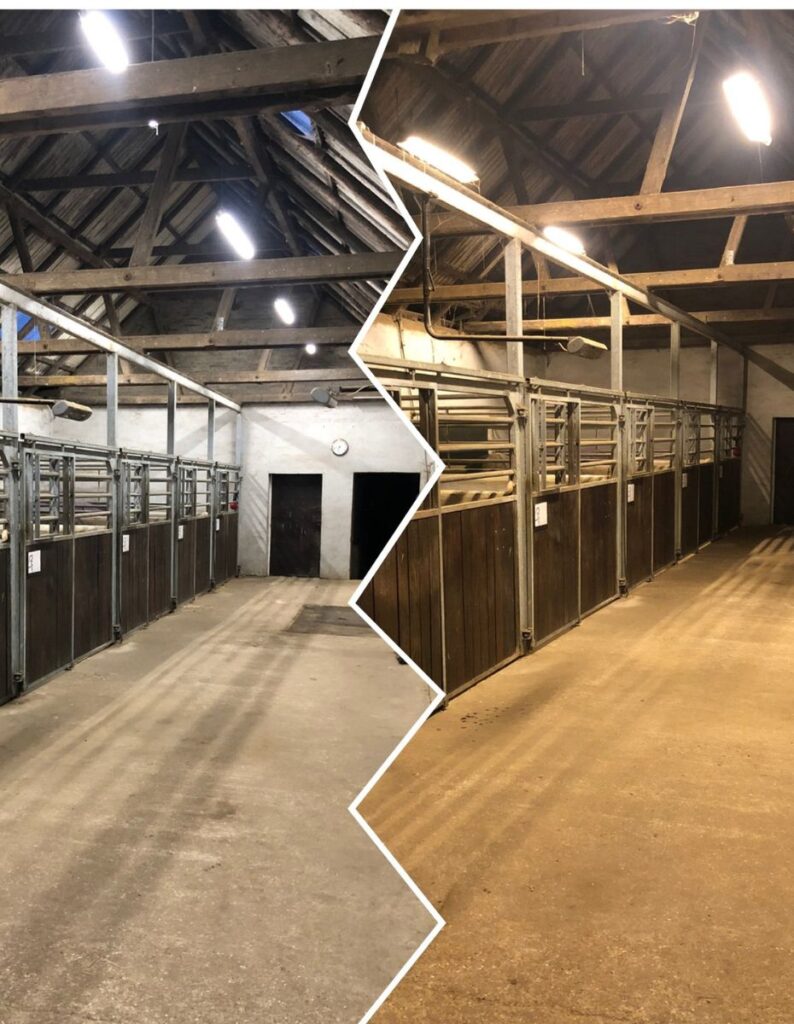
"Collecting rainwater for watering the indoor arena, timers on LED stable lights, and switching to LED lighting in the stable and arena. Better light at a better price!"
"I have solar panels on the roof of my indoor arena."
"LED lights in the stable and indoor arena. Can really be seen on the electricity bill."
"And of course, we have LED lighting."
"LED lights on the riding track, but not yet in the stable. Have a reasonably lit stable, so light is only necessary when it's dark outside."
"Buy second-hand gear. Bridles, pads, covers, etc. Everything that needs to be produced wears on our Earth."
"Like to buy used equipment and sell what I don't use. Buys quality equipment that lasts."
“Waste sorting, all used equipment is passed on or sold. We are willing to buy used equipment - only have what is absolutely necessary."
"The best way to be sustainable is probably to reduce consumption. Consider if the horse can do without a rug. Buy locally produced feed. Use hay instead of haylage if possible (use more roughage and less hard feed). Use straw from local farmers instead of various things in plastic bags. Wear out your riding equipment before buying new. I mean, recycling is great, but it is not the solution. It's raw materials and consumption we need to focus more on."
"And the blue straw strings are great for bundling cardboard for bulk waste. I know someone who uses threads from the green ones as gift ribbons, and it looks really nice. I gladly buy second-hand gear and sell what I don't use. I buy quality equipment that lasts. Hay strings are used to tie cardboard for bulk waste. Unfortunately, we cannot dispose of haylage plastic as bulk waste here (so we have to take it to the recycling centre ourselves), but as a consequence of that, I made a "garden figure" (free-range pig), where I then used haylage plastic to wrap around the pieces of wood in the figure (under the spruce)."

"Using feed bags for garbage bags, for transporting hay, for storage, overnight stays, and competitions. Taking all things from used blankets that can be reused. Saves some of the blue hay strings."
"We have acquired an extra waste bin in addition to those provided by the municipality so that we can separate soft plastic, as we are almost mass producers of it with all the things that come in plastic bags (wood pellets, feed, equipment, etc.)."
"We also struggle with plastic from haylage, but we do deliver it to the recycling station."
READ ALSO: The 5 biggest problems for horse's in frosty weather
"Besides buying most of our equipment used, reducing plastic consumption, reusing buckets, and using only hay as long as possible, we also have a large paddock that is not sprayed or fertilized. This means more wildlife, plants, and happy horses.
Our horses benefit greatly from the trees (bark), the lake (aquatic plants), plants such as nettles (nature's own health providers), organic apple trees (benefits horses, birds, and larvae), hills, and artificial burrows (shelter for the horses, dens for the foxes and ducks)."
"Second-hand riding gear, no food waste in the house (as there is always either a cat, dog, horse, or goat that can eat leftovers. Therefore, food being thrown out can be counted on one hand).
"The dung is spread on one's own land. Food scraps are given to the chickens. It is certainly not easy, but we do the best we can.”
Resistance bands are well known tools in the gym and home workouts for humans, but did you know that they can be very beneficial for your horse as well? One of the most difficult and important aspects of horse training and rehabilitation is engaging the horse's core and hind. As the only scientifically proven resistance band system for horses, the Equiband® Pro System may provide the much-needed engagement in your horses’ body.
Jennifer Zonghetti, owner of Revitalizing Equine Services, LLC, is an equine massage therapist and rehabilitation practitioner based in the United States. She is dedicated to making educational resources accessible to backyard horse owners, ensuring that they have the tools and knowledge to support their horses' health and happiness. Through her work, she aims to empower horse owners with practical, easily digestible information that can be readily applied to benefit their equine companions. Horses have been a part of her life for more than 20 years.
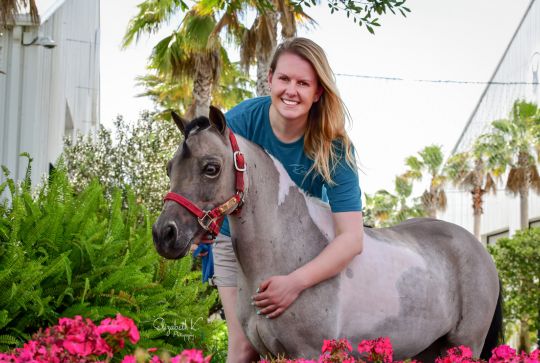
In this article, Jennifer Zonghetti is referring to the Equiband® Pro System by Equicore Concepts LLC as the system of resistance bands she is using. You can use any kind of resistance band suitable for horses, and you just have to find the system and brand of resistance bands that both you and your horse are comfortable with.
The resistance band should provide proprioceptive feedback (training a part of the horse's sensory system) during motion which would help your horse to activate its core abdominal and hindquarter to improve strength and balance in the whole body of your horse.
Resistance bands are long pieces of elastic bands used for resistance training. For humans, they come in a variety of colors, shapes, sizes, and resistance levels, making them a versatile tool for a wide range of exercises. For horses, we use for instance the Equiband® Pro System.
The science behind resistance bands lies in the concept of resistance training. The resistance bands provide a form of resistance that is created by the tension in the band when it is stretched. This resistance challenges the muscles, activating them and creating microtears in the muscle fibers, which are then repaired during the recovery phase. As the muscle fibers repair and rebuild themselves, they become stronger and more resilient. It may sound like a scary process, but this is how muscles are built!
The Equiband® Pro System consists of a saddle pad that comes in multiple sizes (mini, pony, small, regular, and large) along with an English or Western option. It can be used with a surcingle or saddle, while ridden or when doing groundwork exercises. The pad has four buckles; two buckles on each side. One set of buckles is for the belly band that attaches behind the rider’s leg and passes under the abdomen. The second band is the hind-end band that passes behind the horse’s hind end and under the tail. Both bands are latex-free and have been specifically designed to be used on horses.
The Equiband® Pro System stimulates the mechanoreceptors: receptors in the horse’s skin and hair follicles. These receptors trigger the abdominal, deep neck, and back muscles to activate, stabilizing the spine and engaging the hindquarters.
“The key aim of the Equiband®Pro System is to improve core muscle activation through continuous stimulus from parts of the body to the brain, resulting in changes in motor output,” Dr. Nicole Rombach, co-Founder of Equicore Concepts LLC.
We’ve all heard of the saying, “Use it or lose it,” and this applies to horses, too. Resistance bands fall into the category of strength training, which has been shown to be effective in building muscle strength and endurance, improving balance and stability, and enhancing overall fitness. Horses with stronger muscles and core strength can better support their body weight and have a more efficient athletic performance.
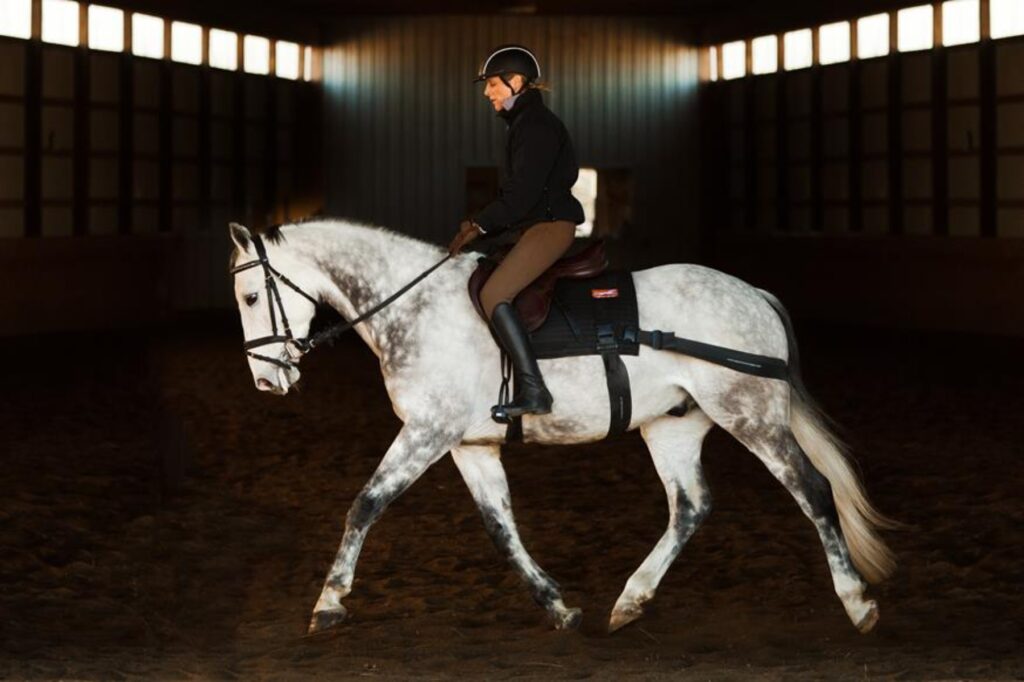
A strong core is a vital component of the horse’s body. The core includes the abdominal muscles and oblique muscles, along with the supporting deep spinal muscles. One of the key components the core contributes to is postural stability. Horses with an optimal body posture effectively utilize their joints and muscles, showcasing efficient and coordinated movement. They are able to move correctly, maintaining a sense of balance and self-carriage. This reduces unwanted strain and stress put on tendons, ligaments, and joints, along with ensuring that muscles are utilized correctly. It also plays a pivotal role in mitigating the risk of injuries. Poor posture can contribute to poor biomechanics, atrophied muscles and compensatory movement patterns. The decrease in all of these components in the horse can lead to early exhaustion, uncomfortable movement, and injuries, which can all have a negative impact on the horse’s body. Horses with a weak core can exhibit but are not limited to hollowing of the back, resistance or difficulty with transitions, lack of engagement in the hind end, asymmetry, or lack of balance and coordination.
Research shows that the Equiband® Pro System is beneficial even with hand walking. After 4 weeks in a resistance band, researchers from the University of Georgia found improved hindlimb symmetry, spinal stability, and less compensatory patterns in horses with mild hindlimb lameness.
Dynamic stability is also a factor to take into account when considering the core and postural strength of a horse. This is the horse's ability to maintain balance and coordination while in motion. It allows the horse to make rapid adjustments in its body position and movements, to stay upright and move efficiently.
This dynamic stability results in a smoother and secure platform for the rider, reducing the risk of imbalance from outside forces, and minimizing the impact on the rider's spine and joints. The effective weight distribution across four legs also lowers the risk of injuries for the horse.
Strength training and conditioning go hand-in-hand. The process involves the gradual building of muscle development to prepare the horse for ridden work. Working in-hand with resistance bands can be used to strengthen the core muscles and can continue to be used as ridden work is introduced to ensure the horse maintains a strong posture. Early strengthening of muscles helps prevent injuries which can set your young horse back.
A strong and engaged core is the foundation for a horse's ability to execute the pirouette and piaffe, or to jump over oxers while still maintaining balance and coordination. By utilizing the resistance band, equine professionals can continue to activate and strengthen the deep muscles surrounding the horse's spine. This focus on core activation not only enhances the horse's athletic performance, but also contributes to the prevention of injuries, ensuring the longevity of a successful and healthy career in the competition world.
As horses age, maintaining a strong core becomes increasingly crucial as loss of muscle mass, quality, and strength become more common as the years progress. Incorporating resistance bands into a regular exercise program can diminish the likelihood of musculoskeletal issues and promote longevity. Investing in the strength and posture of an aged horse can enhance the overall quality of life, allowing the horse to safely navigate through challenges they may face ahead.
Prolonged inactivity due to an injury can cause muscle atrophy. Loss of muscle can cause physical impairment to the body, such as the inability to get up after lying down, decrease in performance ability, and increased risk of injury. The Equiband® Pro System and other resistance bands can aid in core strengthening and movement retraining for horses returning to work.
Resistance bands are a great addition to horses who are recovering from colic surgery, have been diagnosed with kissing spines, or have poor posture, engagement, and development of muscles. They can also be used with horses who are recovering from a musculoskeletal or neurological disorder, and to help with horses who have asymmetrical movement.
The Equiband® Pro System can be used during lunging, groundwork, or while ridden, with or without poles. It is best to start desensitizing your horse to the setup before incorporating it into your horse’s exercise.
When fitting the bands, it is important to keep in mind to have enough tension on the band: it should not be loose or sliding. The band should be snug against the horse’s body; stretched fully then reduced to about 2/3s of the distance between the buckles, for optimal tension. For your horse’s first time wearing the band, it is suggested to start with the abdominal band. The goal is to activate the horse’s trunk core and support the spine, before asking the horse to engage his hind end.
Just like with any muscle-strengthening activity, fatigue can occur. To avoid this, it is best to use the bands for short periods of time to start, and gradually increase as the horse gets stronger. The length of time where resistance bands are used will vary from horse to horse, depending on their physical level. It can take four to six weeks for the body to adapt to the bands, and upwards to three months for the muscles to gain full strength. Because of this, it is advised to use the bands in short, 5-minute sessions to start, multiple days a week, increasing the time as the horse gains strength, while decreasing the number of days it is used. Once the muscles are sufficiently strong, the days and time used can be tapered down to a maintenance schedule.
Week 1: 4-5 days a week for 5minutes
Week 2: 4-5 days a week for 10 minutes
Week 3: 3-4 days a week for 15 minutes
Week 4: 3-4 days a week for 20 minutes
Week 5: 3 days a week for 30 minutes
Overall, the Equiband® Pro System has been proven to strengthen the core, postural stability, and dynamic stability of the horse. It can be safely incorporated into the exercise program of any equine athlete, and aid in rehabilitation from musculoskeletal issues to neurological conditions. When in doubt, consult with a veterinarian if your horse has an undiagnosed lameness or ailment before introducing the Equiband® Pro System or any other resistance bands into their exercise schedule.
This series will shed light on some different disciplines. In the equestrian world, there are more than 50 different disciplines worldwide, each with even more sub disciplines. Most of us do one, two or maximum three disciplines, but what do other equestrians do? We hope this series might help create awareness, show equalities or differences and maybe spark interests.
If Mountain Trail is a new discipline for you, it can be described quite briefly: It's about partnership and collaboration between you and your horse. Although this should naturally be the focus in all riding and handling of horses, it's particularly important in the discipline of Mountain Trail. In Mountain Trail, the goal is to create courage and ensure that both horse and rider are safe in all terrains - one obstacle at a time.
The aim of Mountain Trail is to reflect riding in the mountains and in nature in general. The horse and rider must demonstrate that they can pass obstacles calmly and safely in a harmonious interaction. This can be done from the ground as well as from the saddle, making the discipline open to all types of riders and horses regardless of level. The goal is to create brave and confident pairs that can tackle both large and small challenges, reminiscent of those encountered in nature. The most important aspect is to focus on the behaviour and cooperation between the horse and rider.
Unlike the disciplines of trail and agility, the obstacles in Mountain Trail have a more natural appearance, such as branches, ditches, tree trunks, and hills, which you must navigate together.
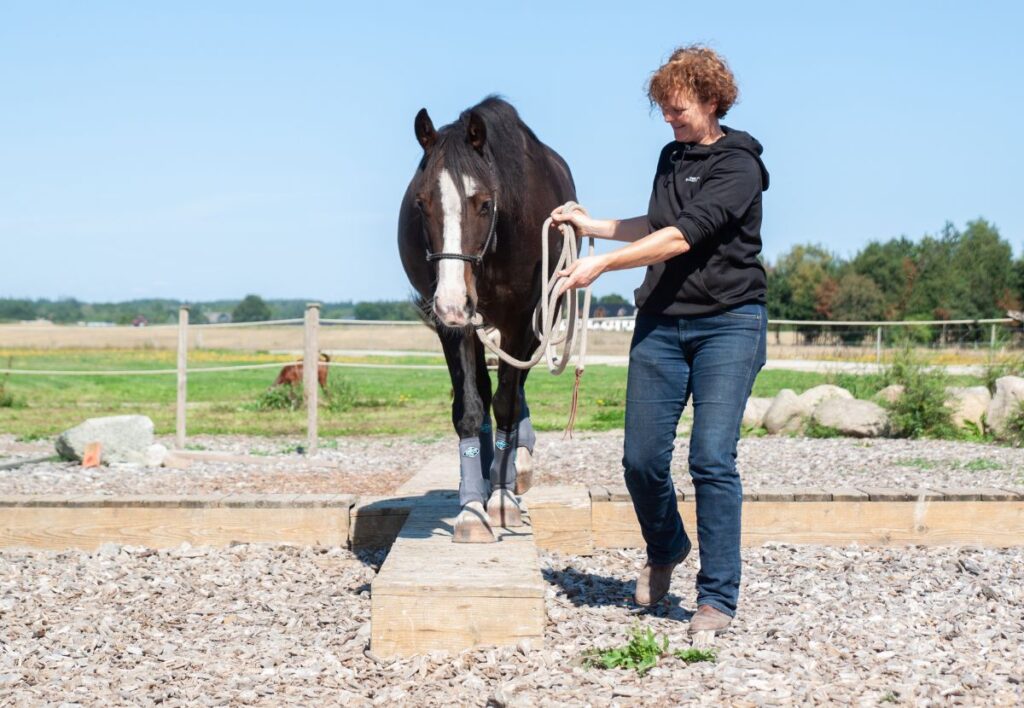
Mountain Trail emerged in 2001 at the Oregon Horse Center. A western trainer had organized a competition where trail classes were set up with tree trunks and other natural obstacles. The idea of reviving many of the old-style trail shows created huge interest in the horse industry. Mark Bolender saw potential in the new sport and has since promoted it worldwide by establishing Mountain Trail courses in the USA, Canada, Australia, and Europe.
Subsequently, Mark Bolender has worked diligently to spread the sport through books, articles, and clinics worldwide. Additionally, he established the set of rules that are used. In many countries, that is still the set of rules that are used, but many countries plan to develop specific rules.
The whole idea behind the obstacles in Mountain Trail is to make them as natural as possible. These could include:
There can also be exercises that require dismounting and remounting during the course.
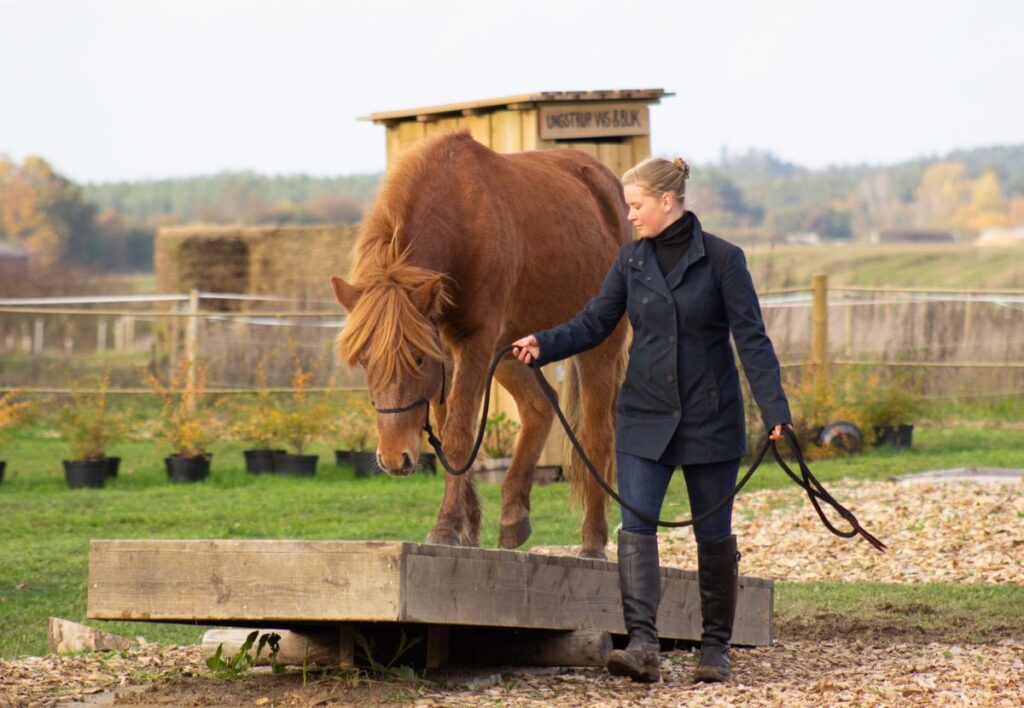
- Quote from the founder of Mountain Trail, Mark Bolender.
In Mountain Trail, there aren't strict requirements for equipment – it just needs to be clean, in good condition, and fitted to the horse. This means you can ride in anything from a halter and bitless bridle to a regular bridle with a bit, but specific rules may apply at each event. Attention may also be paid to the appearance of the equipment – it should not only fit the horse, but aesthetics can also be important.
All breeds can essentially be used for Mountain Trail, as long as they are curious and willing to tackle new challenges with their riders. Even young horses can participate, as they can simply participate with the rider from the ground. This means there is room for everything from Icelandic horses to large warmbloods!
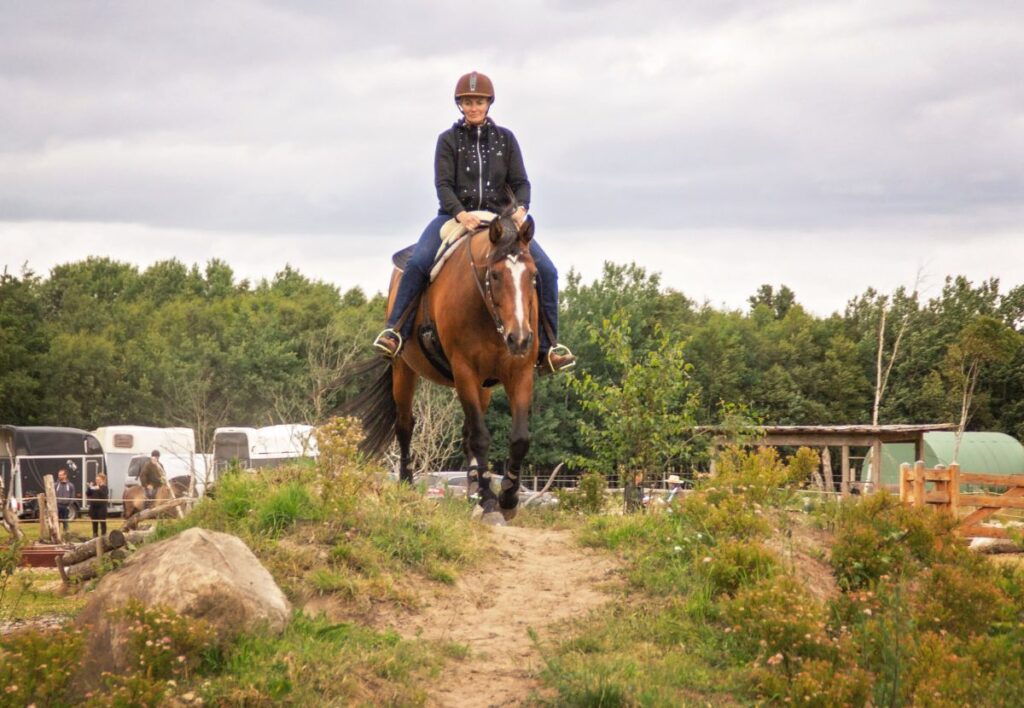
If you're interested in trying Mountain Trail with your horse, it's recommended to take an introductory course at one of the many Horse Parks. Here, one of the park's instructors will go through different types of obstacles so that both you and your horse become comfortable with them.
Even young and older horses can join in, as well as owners any age. At competitions, horses can participate with riders from the ground in the calendar year the horse turns 2 years old.
Mountain Trail competitions requires to have a judge certified as a Mountain Trail judge before you can arrange these events.
In competitions, you compete in Level 1, Level 2, or Level 3. It's possible to complete all three levels from the ground or on horseback.
Every horse and rider should start here if Mountain Trail is new to them. The obstacles will be easy, and as a starting point, they should be completed at a walk, focusing on technique and completing the obstacles.
If you and your horse have mastered the basics, you can try Level 2. Here, you must show that you have good teamwork and mutual trust when completing the different exercises. Additionally, the obstacle course will be longer. It may also be necessary to trot, tölt, or similar either before or between exercises. Furthermore, there may also be 180, 270, or 360-degree turns on selected obstacles.
Here, you really need a good partnership! The course will be longer, and you must be able to complete difficult exercises. Cantering may be included either before or between obstacles, as well as similar turns to those in Level 2.
At a Mountain Trail competition, it's possible to participate in two levels with the same horse. However, it must be either Level 1 and 2 or Level 2 and 3.
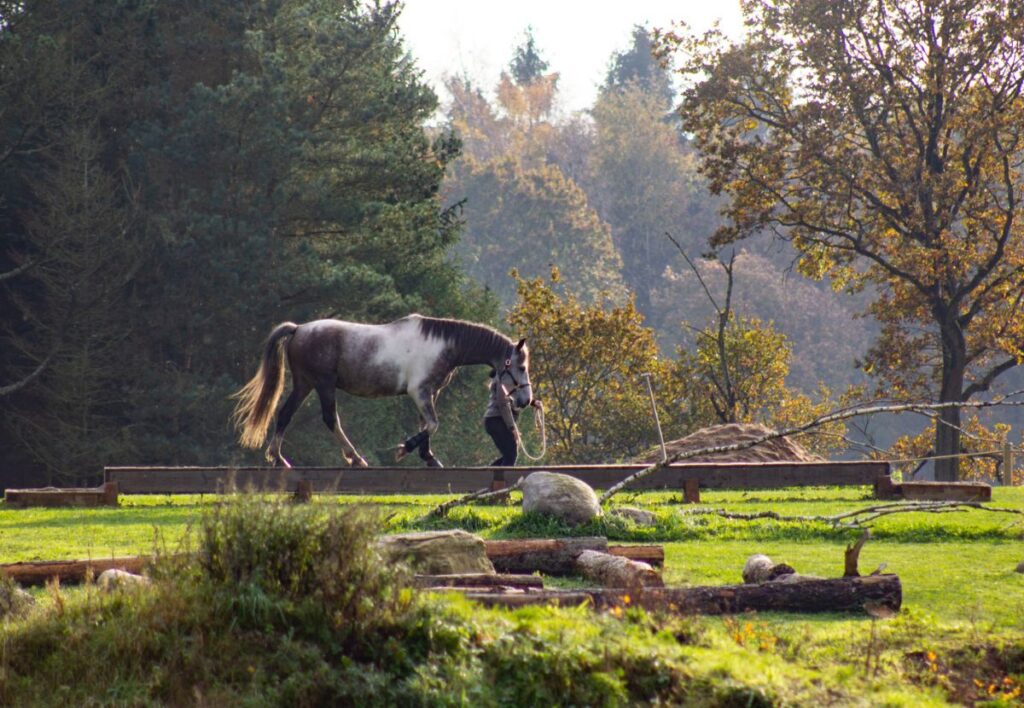
When participating in a competition, you start with 70 points when entering the course. You're evaluated on the horse and rider's ability to navigate the course. The judge then awards points with either 0 or minus points, but it's possible to award +1 for particularly impressive performances. Each exercise has a value of 9 points. Judges assess points for entry to the course, navigation, exit, and there are also both wow points and horsemanship points.
Handler: This could be a child aged at least 6 years or a pair with a handicap that needs to be led.
Child/Junior: This group covers participants under 18 years old as of January 1st and at least 6 years old. There will be classes for both 6-11 year olds and 12-year-olds.
Adult: Participation only requires that you are more than 18 years old as of January.
Open: Everyone can participate. Coaches can only participate in this category.
Find your nearest Mountain Trail park and contact them or find an instructor.
https://mountaintrail.dk/om-mountain-trail
https://imtca.org/wp-content/uploads/2022/03/2022_IMTCA_Rulebook_-Fnl_A.pdf
https://www.bolenderhorsepark.com/imtca-about
https://djurshorsepark.horsepark.dk/om-os